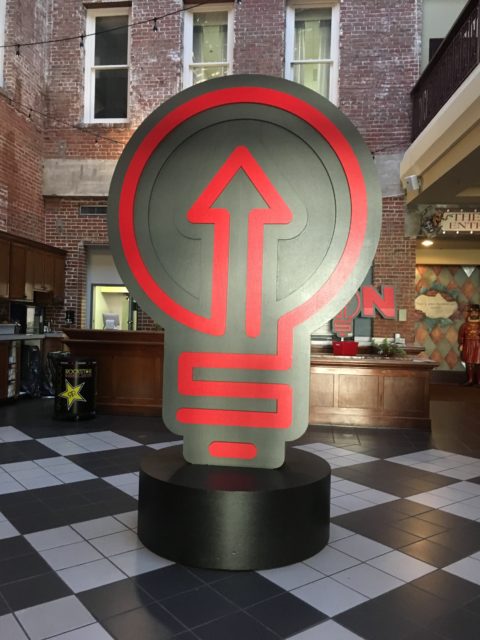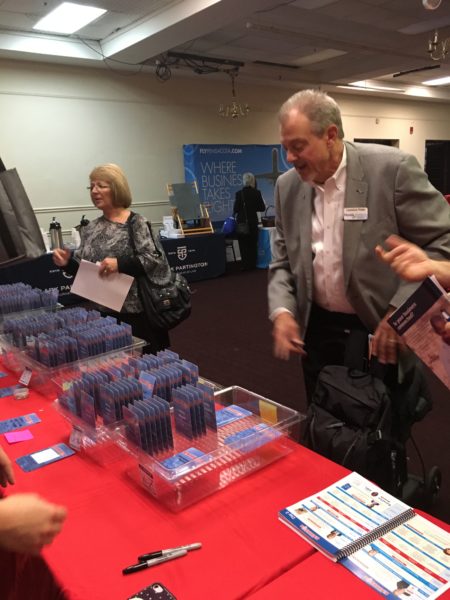EntreCon 2017: Build, Grow, Lead, Develop
- November 14, 2017
- / Shannon Nickinson
- / entrecon,training-development

EntreCon 2017 kicked off Nov. 14 with speakers who preached the power of employee engagement to strengthen and sustain a business — and cautionary tales about how its absence can leave a workplace DOA.
Author and consultant Kevin Sheridan told the audience of more than 400 people at Pensacola Little Theatre that engagement is the secret sauce that makes workplaces hum — but that only about 27 percent of workers are engaged.
The majority — some 60 percent — are what Sheridan calls “the working dead.” That’s the percentage of workers who are not engaged and are not disengaged. They are going through the workday like zombie extras from “The Walking Dead” TV show on AMC.
“You’ve got to reanimate them,” Sheridan said. “Your working dead need to be re-energized.”
Sheridan spoke at the conference, now in its third year. EntreCon has an expanded focus beyond the original focus on entrepreneurs and startups. The lineup of speakers and experts is meant to offer something for everyone.
EntreCon 2017 — which runs over three days from Nov. 14-16 — will focus on Entrepreneurship and Continued Learning, with tactical business advice for business growth and leadership success. There are four themed learning tracks — Build, Grow, Lead, Develop.
That means there will be something for managers, leaders and employees alike — from people looking to build their own skillset, to those looking to build and lead a stronger team. Click here to register for day two.
“Engaged employee have passion for their work and pride in where they work,” Sheridan said.
To get the “working dead” back on your side, Sheridan suggested getting those employees a mentor, “voluntelling” them to serve on a committee or handle a special assignment, and even having the courage as manager to move someone into a different position that better fits them — and the company.
Sheridan is an internationally-recognized speaker, a New York Times Best-Selling author, and one of the most sought-after voices in the world on the topic of employee engagement. His first book, “Building a Magnetic Culture,” made six of the best-seller lists including The New York Times, Wall Street Journal, and USA Today. He is also the author of “The Virtual Manager,” which explores how to most effectively manage remote workers.
Building an engaged workforce ultimately means being smart about hiring, Sheridan says. That means asking behavior-based questions, using tools like peer interviews and coming up with a “non-negotiable” list for your culture. This list of values, behaviors and expectations should be laid out during the interview process.
And those who don’t match up should never make it in the door.
Getting that right fit is critical for businesses with forward-facing customer service as the lynchpin of their work.
“The correlation between engagement and customer service is enormous,” Sheridan says.
That message was reinforced by Scott Ramsay, the Managing Director of Flight Dispatch and Operations Control for American Airlines.
He and his team are responsible for the daily movement of almost 7,000 daily flights at American Airlines and their regional operators.
Some four years ago, American and USAirways merged in an $11 billion deal that created one of the world’s largest airlines. Integrating two company cultures into one is an ongoing process that continues in some ways to this day, Ramsay told the audience.
“I look at creating culture change as an eight to ten year process,” Ramsay says. “I don’t say you create a culture, I say we are creating a culture.”
The best way to do that, is to make sure that front-line employees see and feel that their managers are in it with them, building a legitimate spirit of teamwork that leads to the engagement that experts like Sheridan and others say is so critical to good customer service —and good business.
“You’ve got to be out there with them,” he says.
Sustaining Culture
In an afternoon breakout session, Mark Faulkner, president and CEO of Baptist Healthcare, shared the lessons he’s learned along his leadership journey in the Pensacola-based healthcare company.
To build a culture that embraces engagement, integrity and customer service is one thing. Sustaining it requires constant nourishment, and the courage to examine the foundation for cracks.
Open communication, recognition and reward, alignment and accountability from top to bottom are all critical to keeping a culture healthy. Baptist recently revisited its mission, vision and values,a process that included the input of employees at every level of the organization.
Self-examination like that is not just healthy, Faulkner says it is necessary.
“If you want to take down a culture, you don’t have to sabotage it,” Faulkner said. “Just do nothing. Do nothing and it will wither.”
Practical advice for small businesses
An afternoon session at the Voices of Pensacola museum focused on problem-solving and practical advice for small businesses and entrepreneurs from two local experts.
The session was led by Kelly Massey, director of the Florida Small Business Development Center at the University of West Florida, and Mort O’Sullivan, managing member of the Gulf Coast Division Warren Averett CPA’s and Advisors.
Massey and O’Sullivan covered business basics, took questions from the audience and offered hands-on advice on everything why Quickbooks should become your best friend, the tax benefits of various corporate structures, understanding marketing and audience to the perils of hanging on to low performers.
“People want to lead with their heart,” O’Sullivan said. “But make that hard decision early. You will do that person a blessing by helping them find a better fit.”
“Don’t try to do everything,” Massey said. “Find people to advise you about what you don’t know about.”
Resources in the community, including the SDBC, can be a deep — and free — resource. Use them.
A social media strategy
In the session, “Social Media: Lead or Catch Up,” Lisa Long told a packed audience at 5ElevenPalafox about the importance of developing a social media strategy to reach customers and increase profits.
Long, founder of Red Iron Design House, emphasized the need to plan strategically, focusing on three things: vision, mission and the why.
“Ask where do I want to be in five years and how will get there,” Long said. “Your mission is the roadmap.”
Ensure that your customers, clients and audience understand the why and always keep it in the forefront, Long said.
“When you know your why your what has more impact because you’re walking in and toward your purpose,” Long said.
Of 2 billion users, Facebook posts get about 1.7 seconds views, Long said, and about 5.7 seconds on videos.
Facebook’s most aggressive transformation since 2012 has been the use of videos, Long said.
“Users should start incorporating videos or platforms won’t be as successful,” Long said. “And if you want growth, don’t forget to tell your why.”
Profit or perish
An afternoon session at Pensacola Museum of Arts made it clear that if a company can’t grow and isn’t profitable it will not succeed.
Tommy Duncan, a healthcare entrepreneur and CEO of Trusted Partner Health Plan, led an afternoon session at Pensacola Museum of Arts. He made it clear that a company will go under quickly if it no one is paying extra attention on the bottom line.
“It’s important to take every penny seriously and be profitable early,” Duncan said. “Invest in good, smart help, not your cousins, interns or cheap labor.”
When he bought his company, Duncan was losing $2 million in the first 12 months, even though a lot of revenue was flowing in.
Duncan said he dug deep in business, tightened up and made the necessary corrections and at the end of the year he made a profit of $ 8 million.
“I became profitable in business because we’re detail-oriented,” Duncan said. “We watch the bottom line and offer good customer service.”
To be successful, entrepreneurs must invest in their strategy and dive, not limp in, Duncan said.
“Put a force-field around business to protect profits,” Duncan said. “Fight for every dollar because every dollar matters.”
Block the bad, harness the good
Day one closed with Liz Jazwiec, president of Liz Jaz. The longtime hospital officer and former emergency room nurse, shared a session filled with humor and good advice.
Much of it centered around harnessing the good in the workplace and starving the negativity out of the culture. It’s a theory that holds that by consciously making time to recognize the positive things that we and our co-workers do every day, we take ownership of our own engagement.
We make a better place to work for our peers, and we make a better place for our customers to be.
“Long-term satisfaction with any job comes from knowing the work I do has purpose and meaning,” Jazweic. “It comes from knowing that when I walk through the door, I make a difference.”
Jazweic says she was a late convert to the mantra of focusing on customer service to improve engagement. But it was a conversion she is deeply grateful she made. In the beginning, she says, she felt like asking her team to focus on customer service was like asking them to add a duty onto their already busy day.
“I didn’t want to make their job harder,” she says. “(But) I don’t think people realize it is always the little things that matter most to customers.”
At first, she says, she thought that meant looking for a big “wow” moment of an amazing, transcendent customer interaction or experience.
Turns out, she says, that “wow” moment is almost always what seems like a small thing.
“Wow is not big,” she says. “Wow is personal.”
Reggie Dogan contributed to this report.

 CivicCon launches with a look at good growth in cities
CivicCon launches with a look at good growth in cities
 Building stronger brains one baby, one parent at a time
Building stronger brains one baby, one parent at a time
 SCI debuts commercial on Early Learning City
SCI debuts commercial on Early Learning City
 Entrecon: World class speakers and an opportunity to sharpen skills
Entrecon: World class speakers and an opportunity to sharpen skills
 PYP Quality of Life survey 2017
PYP Quality of Life survey 2017
 EntreCon Pensacola 2016: A look back
EntreCon Pensacola 2016: A look back
 Leadership tip: getting better employee takeaways
Leadership tip: getting better employee takeaways
 Leadership tip: be interested instead of interesting
Leadership tip: be interested instead of interesting
 Leadership tip: delivering difficult messages
Leadership tip: delivering difficult messages
 Brain Bags boost Arc, Early Childhood Court programs
Brain Bags boost Arc, Early Childhood Court programs